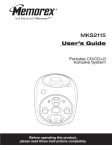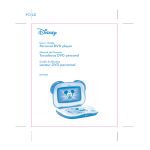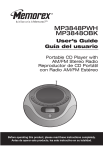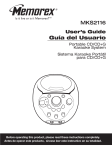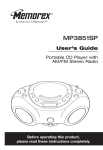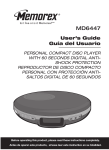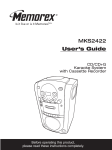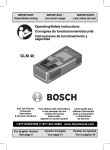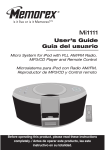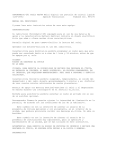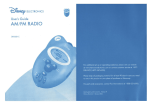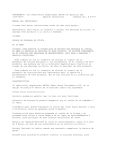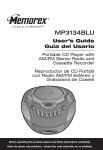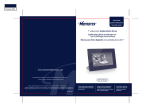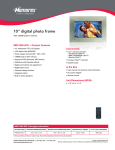Download Memorex MKS-SS1 User's Manual
Transcript
MKS-SS1 User’s Guide Sing Stand Karaoke System Before operating this product, please read these instructions completely. Dear Customer, Please read this manual thoroughly before operating the unit to become more familiar with it and obtain the performance that will bring you continued enjoyment for many years. Keep these instructions handy for future reference. PLEASE KEEP ALL PACKAGING MATERIAL FOR AT LEAST 90 DAYS IN CASE YOU NEED TO RETURN THIS PRODUCT TO YOUR PLACE OF PURCHASE OR IMATION ELECTRONIC PRODUCTS. For future reference, record the serial number of the unit printed on the rear of the cabinet. Serial Number _______________________________________ CAUTION INFORMATION This product has been tested and found to comply with the limits for a Class B digital device pursuant to Part 15 of the FCC Rules. These limits are designed to provide reasonable protection against harmful interference in a residential installation. This equipment generates, uses, and can radiate radio frequency energy and, if not installed and used in accordance with the instructions, may cause interference with radio communications. However, there is no guarantee that interference will not occur in a particular installation. If this product does cause harmful interference to radio or television reception, which can be determined by turning the equipment off and on, you are encouraged to try to correct the interference by one or more of the following measures: • Reorient or relocate the receiving antenna. • Increase the separation between the equipment and receiver. • Connect the equipment into an outlet on a circuit different from that to which the receiver is connected. • Consult the dealer or an experienced radio/TV technician for help. RISK OF ELECTRIC SHOCK DO NOT OPEN CAUTION: TO REDUCE THE RISK OF ELECTRIC SHOCK, DO NOT REMOVE COVER (OR BACK). NO USER-SERVICEABLE PARTS INSIDE. REFER SERVICING TO QUALIFIED SERVICE PERSONNEL. This Caution Marking and Rating Label are located at the bottom enclosure of the unit. DANGEROUS VOLTAGE: The lightning flash with arrowhead symbol within an equilateral triangle is intended to alert the user to the presence of uninsulated dangerous voltage within the product’s enclosure that may be of sufficient magnitude to constitute a risk of electric shock to persons. ATTENTION: The exclamation point within an equilateral triangle is intended to alert the user to the presence of important operating and maintenance (servicing) instructions in the literature accompanying the appliance. FCC WARNING: This equipment may generate or use radio frequency energy. Changes or modifications to this equipment may cause harmful interference unless the modifications are expressly approved in the instruction manual. The user could lose the authority to operate this equipment if an unauthorized change or modification is made. ATTENTION: POUR ÉVITER LES CHOC ÉLECTRIQUES, INTRODUIRE LA LAME LA PLUS LARGE DE LA FICHE DANS LA BORNE CORRESPONDANTE DE LA PRISES ET POUSSER JUSQU’AU FOND. This Class B digital apparatus complies with Canadian ICES-003. Cet appareil numérique de la classe B est conforme à la norme NMB-003 du Canada. WARNING: TO PREVENT FIRE OR SHOCK HAZARD, DO NOT EXPOSE THIS UNIT TO RAIN OR MOISTURE. SURGE PROTECTORS: It is recommended to use a surge protector for AC connection. Lightning and power surges ARE NOT covered under warranty for this product. 1 Dear Customer: Selecting fine audio equipment such as the unit you’ve just purchased is only the start of your musical enjoyment. Now it’s time to consider how you can maximize the fun and excitement your equipment offers. This manufacturer and the Electronic Industries Association’s Consumer Electronics Group want you to get the most out of your equipment by playing it at a safe level. One that lets the sound come through loud and clear without annoying blaring or distortion-and, most importantly, without affecting your sensitive hearing. Sound can be deceiving. Over time your hearing “comfort level” adapts to higher volumes of sound. So what sounds “normal” can actually be loud and harmful to your hearing. Guard against this by setting your equipment at a safe level BEFORE your hearing adapts. To establish a safe level: • Start your volume control at a low setting. • Slowly increase the sound until you can hear it comfortably and clearly, and without distortion. Once you have established a comfortable sound level: • Set the dial and leave it there. Taking a minute to do this now will help to prevent hearing damage or loss in the future. After all, we want you listening for a lifetime. We Want You Listening For A Lifetime Used wisely, your new sound equipment will provide a lifetime of fun and enjoyment. Since hearing damage from loud noise is often undetectable until it is too late, this manufacturer and the Electronic Industries Association’s Consumer Electronics Group recommend you avoid prolonged exposure to excessive noise. This list of sound levels is included for your protection. Decibel Level 30 40 50 60 70 80 Example Quiet library, soft whispers Living room, refrigerator, bedroom away from traffic Light traffic, normal conversation, quiet office Air conditioner at 20 feet, sewing machine Vacuum cleaner, hair dryer, noisy restaurant Average city traffic, garbage disposals, alarm clock at two feet THE FOLLOWING NOISES CAN BE DANGEROUS UNDER CONSTANT EXPOSURE: Subway, motorcycle, truck traffic, lawn mower Garbage truck, chain saw, pneumatic drill Rock band concert in front of speakers, thunderclap Gunshot blast, jet engine Rocket launching pad O C IND TR N A EST. 1924 O O C I A TI IES ELECT U EIA S S 2 NI S Information courtesy of the Deafness Research Foundation. R 90 100 120 140 180 We Want You LISTENING For A Lifetime IMPORTANT SAFETY INSTRUCTIONS Read these instructions before using this product. 1. Read these instructions. 2. Keep these instructions. 3. Heed all warnings. 4. Follow all instructions. 5. Do not use this apparatus near water. 6. Clean only with a dry cloth. 7. Do not block any ventilation openings. Install in accordance with the manufacturer's instructions. 8. Do not install near any heat sources, such as radiators, heat registers, stoves or other apparatus (including amplifiers) that produce heat. 9. Do not defeat the safety purpose of the polarized or grounding-type plug. A polarized plug has two blades with one wider than the other. A grounding-type plug has two blades and a third grounding prong. The wider blade or third prong are provided for your safety. When the provided plug does not fit in your outlet, consult an electrician for replacement of the obsolete outlet. 10. Protect the power cord from being walked on or pinched, particularly at plugs, convenience receptacles, and the point where they exit from the apparatus. 11. Only use attachments or accessories specified by the manufacturer. 12. Use only with the cart, stand, tripod, bracket or table specifed by the manufacturer, or sold with the apparatus. When a cart is used, use caution when moving the cart/apparatus combination to avoid injury from tip-over. 13. Unplug this apparatus during lightning storms or when unused for long periods of time. 14. Refer all servicing to qualified service personnel. Servicing is required when the apparatus has been damaged in any way such as power supply cord or plug is damaged, liquid has been spilled or objects have fallen into the apparatus, the apparatus has been exposed to rain or moisture, does not operate normally, or has been dropped. 15. This apparatus shall not be exposed to dripping or splashing and that no objects filled with liquids, such as vases, shall be placed on the apparatus. 16. Mains plug is used as a disconnect device and it should remain readily operable during intended use. In order to disconnect the apparatus from the mains completely, the mains plug should be disconnected from the mains socket outlet completely. 17. For sufficient ventilation, the minimum distance around the apparatus is 10cm. 18. The ventilation should not be impeded by covering the ventilation openings with items such as newspaper, table-cloths, curtains, etc. 19. No naked flame sources, such as lighted candles, should be placed on the apparatus. 20. Only use the apparatus in moderate climates. 3 TOP LOCATION OF CONTROLS 1 2 4 TOP 1. Microphone (PART NO. 5249-06070-E010*) 2. Microphone ON/OFF Switch (on Microphone Handle) 3. Microphone Adjustment Knob 4. Microphone Holder 5. Multimedia Player Holder (PART NO. 4626-260750010*) 6. Top Stand Bar 7. Top Stand Connector/ Adjustment Knob 8. Wire Clip with Mic Holder (PART NO. 4626-360750010*) 9. Middle Stand Bar 10. Connector 11. Wire Clip (PART NO. 4626-46075-0010*) 12. Lower Stand Bar 13. Amp 3 5 6 7 8 9 10 11 12 13 SIDE OF AMP SIDE OF AMP 1. Mic 2 Jack 2. Guitar In Jack 3. Audio Input Jacks 4. Headphone Jack 5. AC Cord 1 2 3 4 5 4 *Consumer Replaceable Part (See page 13 to order.) AMP LOCATION OF CONTROLS 1 9 2 10 3 4 5 11 6 12 7 8 1. 2. 3. 4. 4. 6. 7. 8. 9. 10. 11. 12. MIC 1 In Jack Left Speaker Power Indicator Power Button MIC 1 Volume Control Auto VOCAL Control MIC 2 Volume Control Master Volume Control MEDIA In Jack (LINE IN CABLE PART NO. 2265-32000-E035*) Right Speaker GUITAR Volume Control Echo Control *Consumer Replaceable Part (See page 13 to order.) 5 ASSEMBLY 1 2 Screw the Lower Stand Bar into the Amp and rotate clockwise until tight. Unscrew the Top Stand Connector from the Upper and Middle Stand bars. Insert the Wire Clip with Mic Holder onto the Middle Stand Bar. 3 4 Lower the Top Stand Connector and then rotate clockwise to tighten. Insert the Wire Clip onto the Lower Stand Bar. 5 6 B A Unscrew the stand connector and insert the Middle Stand Bar into the Lower Stand Bar, making sure to align the tabs marked A and B in the illustration. Lower the Stand Connector and rotate clockwise to tighten. 6 7 ASSEMBLY 8 Insert the Multimedia Player Holder onto the Top Stand Bar and rotate clockwise until tight. Insert the microphone into the top Microphone Holder. Rotate the Microphone Adjustment Knob counter-clockwise to loosen and clockwise to tighten the Microphone Holder. Run the wires through the Wire Clips. 9 Insert the Microphone’s Plug into the MIC1 jack on the top of the Amp. 7 CONNECTIONS HEADPHONES JACK CONNECTING A GUITAR For private listening, connect 3.5mm (32 ohm) stereo headphones (not included) to this jack. The speakers are automatically disconnected when the headphones plug is inserted in the jack. Insert a cable from the AUDIO OUT jack on your Guitar to the Guitar In jack on the side of this unit. 1 1 USING A SECOND MICROPHONE 1 To use a second microphone (not included), insert it into the Wire Clip with Mic Holder, then run the wires through the Wire Clips. Insert the Microphone’s Plug into the MIC2 jack on the side of the Amp. 8 CONNECTIONS (CONTINUED) CONNECTING AN EXTERNAL UNIT You can connect an external unit to this unit, such as a CD/CD+G player, etc. Simply connect an audio cable (not included) from the Audio Input jacks on this unit to the external unit's AUX OUT jacks. This will allow you to broadcast the external unit's sound through this unit’s speakers. Make sure both units are turned on and adjust the volume using the Master Volume control. NOTES: • Connecting the unit to an external audio source will allow you to broadcast the external unit’s sound through this unit’s speakers. • When connecting the external unit, refer to the owner’s manual of the external unit, as well as this manual. • When connecting the external unit, make sure the power is off and both units are unplugged before making any connections. • Connect a CD+G player to utilize the Auto VOCAL button, see the following page. • The Line in cable cannot be connected when the Audio In cable is connected. USING A MULTIMEDIA PLAYER 2 1 OR Insert your multimedia player into the Multimedia Player Holder. Fish the included Line In Cable from the rear of the unit and into the side or top of the Multimedia Player Holder as shown. Connect the Line In Cable from the LINE OUT of your multimedia player to the MEDIA IN jack on the top of the amp. Connecting the multimedia player will allow you to hear its sound through this unit’s speakers. 9 POWER SOURCE AC: Use the AC polarized line cord included with the unit for operation on AC power. Insert into a conveniently located AC outlet having 120V, 60Hz. NOTE: The AC plug supplied with the unit is polarized to help minimize the possibility of electric shock. If the AC plug does not fit into a nonpolarized AC outlet, do not file or cut the wide blade. It is the user’s responsibility to have an electrician replace the obsolete outlet. ECHO CONTROL AC Outlet AC Plug OPERATION AUTO VOCAL BUTTON 1 1 Rotate the ECHO control clockwise to increase the echo or counterclockwise to decrease the echo. When connected to an external unit that is capable of CDG disc playback: When the Vocal Auto feature is activated, the vocals on a multiplex recording are muted as soon as the singer begins singing into the microphone. When the singer stops singing, the vocals are automatically unmuted. Press the Auto VOCAL button to the “in” position to activate this feature. MIC ON/OFF SWITCH STAND ADJUSTMENT To turn the microphone on, slide the ON/OFF switch, located on the side of the microphone, to the ON position. To turn the microphone off, slide the ON/OFF switch to the OFF position. To lower or raise the Top Stand bar, simple rotate the Top Stand Connector/Adjustment Knob counter-clockwise to loosen and then raise or lower the Top Stand Bar. Rotate the Top Stand Connector/Adjustment Knob clockwise to tighten. 1 1 10 1 OPERATION (CONTINUED) 2 3 Make any desired connections as shown on pages 8 and 9. Press the Power button to turn the unit on; the Power indicator will light. Adjust MIC1 Volume control as desired. If using a second microphone, adjust MIC2 Volume control as desired. 4 5 6 Rotate the ECHO control clockwise to increase the echo or counterclockwise to decrease the echo. Turn microphone’s ON/OFF switch to the ON position. Repeat for microphone 2, if desired. Press the Auto VOCAL button to activate the Vocal Auto feature (when using an external unit with CDG). When activated, the vocals on a multiplex recording are muted as soon as the singer begins singing. When the singer stops singing, the vocals are automatically unmuted. 7 8 9 2 1 Turn on the external unit and/or multimedia player and sing or talk into the microphone (s) and you will hear both the external unit/multimedia player and the microphone. If a Guitar is connected, set the desired volume using the GUITAR Volume control. 11 Adjust the MASTER VOLUME control 1 as desired; this will control the overall volume of all connected units/microphones. Press the Power button 2 to turn the unit off; the Power indicator will turn off. TROUBLESHOOTING GUIDE Should this unit exhibit a problem, check the following before seeking service: Symptom: Squealing through the speakers. Possible Solution: This is microphone feedback, see below for more information. Symptom: No Sound (General): Possible Solution 1: Master Volume control is set to minimum, increase. Possible Solution 2: Power is off, turn on; the Power indicator will light. Possible Solution 3: Headphones are plugged into the Headphones jack; unplug. Symptom: No Sound from microphone(s). Possible Solution 1: Microphone is not plugged into the MIC1 or 2 jack. Possible Solution 2: MIC1/2 Volume controls are set to minimum, increase. Symptom: No Sound from guitar. Possible Solution 1: Guitar is not plugged into the Guitar jack. Possible Solution 2: Guitar Volume control is set to minimum, increase. Symptom: No Sound from multimedia player. Possible Solution: Check Line In cable is connected from the multimedia player’s line out jack to this unit’s MEDIA IN jack. MICROPHONE FEEDBACK: “Feedback” is a howling or screeching sound that occurs when the microphone(s) comes too close to the speaker. To avoid microphone feedback, keep the microphone(s) as far away from the speaker as the microphone cable(s) will allow. If you must bring the microphone(s) close to the speaker, such as when you are changing a disc or adjusting one of the other controls on the front of the unit, set the microphone(s) ON/OFF switch(es) to the OFF position. 12 SPECIFICATIONS GENERAL: Power Source .............................................................................................120V, 60Hz AC Power Consumption ....................................................................................................20W Speaker ...................................................................................................................4 ohms Dimensions............................................................................48 (H) x 13 (D) Inches (Min.) Weight........................................................................................................................11 lbs Output Power................................................................................................................5 W Specifications are subject to change without notice. FOR ADDITIONAL SET-UP OR OPERATING ASSISTANCE, PLEASE VISIT OUR WEBSITE AT: WWW.MEMOREXELECTRONICS.COM OR CONTACT CUSTOMER SERVICE: For customers calling within US, call 1-800-919-3647. For customers calling within Mexico, call 001-866-580-8316. PLEASE KEEP ALL PACKAGING MATERIAL FOR AT LEAST 90 DAYS IN CASE YOU NEED TO RETURN THIS PRODUCT TO YOUR PLACE OF PURCHASE OR IMATION ELECTRONIC PRODUCTS. FOR CONSUMER REPLACEABLE PART(S), SEE PART NUMBER(S) ON PAGES 4 AND 5 AND THEN CONTACT FOX INTERNATIONAL AT 1-800-321-6993. 13 Imation Electronic Products, A Division of Imation Enterprises Corp. Weston, FL Printed in / Impreso en Hong Kong www.memorexelectronics.com 5201-06075-E010 MKS-SS1 User’s Guide Guía del usuario Sing Stand Karaoke System Sistema de karaoke vertical para cantar Before operating this product, please read these instructions completely. Antes de operar este producto, s rvase leer este instructivo en su totalidad. Estimado Cliente: Sírvase leer este manual detenidamente antes de operar la unidad para familiarizarse más con el producto y obtener el desempeño que le permitirá disfrutarla por muchos años. Mantenga estas instrucciones a la mano para futura referencia. CONSERVE EL EMPAQUE DE CARTÓN AL MENOS POR 90 DÍAS POR SI ACASO NECESITARA REGRESAR EL PRODUCTO A SU DISTRIBUIDOR O A IMATION ELECTRONIC PRODUCTS. Para futura referencia, registre el número de serie de la unidad impreso en la parte trasera del gabinete. Número de Serie _______________________________________ CUIDADO RIESGO DE DESCARGA ELÉCTRICA. NO ABRIR PRECAUCIÓN: PARA REDUCIR EL RIESGO DE ELECTROCUTAMIENTO, NO QUITE LA CUBIERTA (O TAPA POSTERIOR). NO HAY PARTES ADENTRO QUE EL USUARIO PUEDA REPARAR. REMITA LAS REPARACIONES AL PERSONAL DE SERVICIO CALIFICADO. Esta etiqueta con marca de alerta y clasificación se encuentra en el gabinete inferior de la unidad. ADVERTENCIA: La figura de la flecha con forma de rayo dentro de un triángulo está hecho para alertar al usuario de la presencia de cables sin aislar de “voltaje peligroso” dentro del gabinete, de tal magnitud que puede causar un riesgo de descarga eléctrica a las personas. ADVERTENCIA: El signo de exclamación dentro de un triángulo está hecho para alertar al usuario de la existencia de instrucciones importantes tanto de servicio como de funcionamiento y mantenimiento que vienen con la unidad. AVISO DE LA FCC (sólo válido en Estados Unidos de América): Este equipo genera o puede usar energía de frecuencia radial. Cualquier cambio o modificación al equipo, pueden causar interferencia nociva, a menos que estas modificaciones esten expresamente indicadas en el manual de instrucciones. El usuario puede perder el derecho de operar este equipo si efectuara un cambio o modificación no autorizadas. ATTENTION: POUR ÉVITER LES CHOC ÉLECTRIQUES, INTRODUIRE LA LAME LA PLUS LARGE DE LA FICHE DANS LA BORNE CORRESPONDANTE DE LA PRISES ET POUSSER JUSQU’AU FOND. ADVERTENCIA: PARA EVITAR LOS PELIGROS DE ELECTROCUTAMIENTO O INCENDIO, NO EXPONGA ESTE APARATO A LA LLUVIA O HUMEDAD. PROTECTORES DE SOBRETENSIÓN: Se recomienda utilizar un protector de sobretensión para la conexión de la CA. Los picos de tensión producidos por relámpagos y sobrecarga eléctrica no están amparados por la garantía de este producto. AVISO DE LA FCC (sólo válido en Estados Unidos de América): Este sistema cumple con los límites exigidos a los dispositivos electrónicos Clase B, tal como se especifica en la Parte 15 de las normas de la FCC. Estos límites ofrecen una protección razonable contra la interferencia de radio o televisión, en la instalación residencial. Este equipo genera, usa y puede radiar energía de radiofrecuencia y, si no se lo instala y utiliza de acuerdo con las instrucciones, puede provocar interferencia perjudicial a las comunicaciones radiales. No obstante, no se garantiza que no se producirá interferencia en instalaciones particulares. Si este equipo provoca interferencia perjudicial a la recepción de radio o televisión, lo que se puede determinar encendiendo y apagando el artefacto, el usuario debe intentar corregir la interferencia de una o más de las siguientes medidas correctivas: • Re-oriente o cambie de posición la antena receptora. • Aumente la distancia existente entre el sistema y el radio o televisión. • Use distintos toma-corrientes para el radio o la televisión. • Si el problema subsiste, consulte a un técnico especializado en radio/televisión. Este aparato digital de Clase B cumple con la norma ICES-003 de Canadá. Cet appareil numérique de la classe B est conforme à la norme NMB-003 du Canada. 1 Estimado cliente: Este fabricante y el Grupo de Consumidores de Productos Electrónicos de la Asociación de Industrias Electrónicas desean que usted obtenga el mejor resultado de su equipo usándolo en un nivel seguro, es decir, para escuchar un sonido claro y sonoro, sin distorsión, sobre todo sin que afecte su sentido auditivo. El sonido es engañoso, ya que con el tiempo su nivel de audición puede adaptarse solo a escuchar en volumen alto, resultando en un serio daño a su sentido auditivo. Protéjase contra este daño innecesario ajustando el volumen de su equipo a un nivel bajo antes de acostumbrarse a escuchar siempre la música en un volumen alto. Para establecer un nivel auditivo seguro: • Ponga el control de volumen en posición baja. • Lentamente aumente el nivel hasta que usted pueda escuchar clara y confortablemente sin distorsión. Una vez que establece el nivel de audición confortable: • Deje fijo el control de Volumen en dicho nivel. Esto sólo le tomará un minuto, y le ayudará a prevenir la pérdida del oído en el futuro. Nosotros deseamos que usted pueda oir durante toda su vida Si sabe usar su equipo, éste le proveerá mucho tiempo de satisfacción y entretenimiento. Debido a que el daño causado al oido es imperceptible hasta que ya es muy tarde, este fabricfante y la Asociación de Industrias Electrónicas le recomiendan evitar la exposición prolongada a ruidos excesivos. La lista que le damos a continuación le servirá de guía: Nivel de Decibeles 30 40 50 60 70 80 Ejemplo Una biblioteca, susurros. Sala, refrigerador, dormitorio lejos del tráfico. Tráfico reducido, conversación no rmal, oficina tranquila. Aire acondicionado a 20 pies, máquina de coser Aspiradora de polvo, secadora de pelo, restaurant bullicioso. Tráfico de la calle, destructores de basura, alarma de reloj a dos pies. 90 100 120 140 180 Subterráneo, motocicletas, tráfico de camiones, cortadora de césped. Camión de basura, sierra eléctrica, perforadora neumática. Concierto rock delante de los parlantes, ruido de truenos. Sonido de disparo, motor de jet. Lanzamiento de una nave espacial. LOS SIGUIENTES RUIDOS PUEDEN SER PELIGROSOS SI SE SOMETE A ELLOS EN FORMA CONSTANTE IND U N EST. 1924 O O C I A TI IES ELECT R C EIA S S 2 NI TR A (válido en Estados Unidos de América) O S Esta información ha sido proporcionada gratuitamente por la Fundación de Investigación de la Sordera. We Want You LISTENING For A Lifetime INSTRUCCIONES IMPORTANTES DE SEGURIDAD Lea las siguientes instrucciones antes de utilizar este producto. 1. Lea las siguientes instrucciones. 2. Conserve estas instrucciones. 3. Preste atención a todas las advertencias. 4. Respete todas las instrucciones. 5. No utilice este artefacto cerca del agua. 6. Límpielo únicamente con un paño seco. 7. No obstruya las aberturas para ventilación. Realice la instalación de acuerdo con las instrucciones del fabricante. 8. No instale la unidad cerca de fuentes de calor, como radiadores, rejillas de calefacción, estufas u otros artefactos (incluyendo los amplificadores) que irradian calor. 9. No anule el propósito de seguridad del enchufe polarizado o con descarga a tierra. El enchufe polarizado tiene dos clavijas y una de ellas es más ancha que la otra. Los enchufes con conexión a tierra poseen dos clavijas y una tercera punta de conexión a tierra. La clavija ancha o la tercera punta se proveen por cuestiones de seguridad. Si el enchufe suministrado no cabe con su tomacorriente, consulte con un electricista para reemplazar el tomacorriente obsoleto. 10. Evite pisar o apretar el cable de alimentación, especialmente en los enchufes, tomacorrientes y en el punto por donde salen del artefacto. 11. Utilice sólo los complementos o accesorios especificados por el fabricante. 12. Utilice sólo con el carro, soporte, trípode, repisa o mesa especificados por el fabricante o que vengan con el artefacto. Cuando se utiliza un carro, tenga cuidado cuando mueva el conjunto de carro y artefacto para evitar lesiones producidas por la caída del producto. 13. Desenchufe este artefacto durante las tormentas eléctricas o cuando no se lo utilice durante períodos prolongados. 14. Derive todas las reparaciones al personal de reparaciones calificado. Es necesario reparar el artefacto cuando está dañado de alguna manera, por ejemplo, cuando el cable de suministro de energía o el enchufe están dañados, cuando se derrama líquido sobre la unidad o caen objetos dentro de la misma, cuando el producto ha estado expuesto a la lluvia o a la humedad, cuando no funciona con normalidad o cuando se ha caído. 15. Este artefacto no debe exponerse a goteo o salpicaduras y no se deberán colocar objetos con líquido, como jarrones, encima del aparato. 16. El enchufe se utiliza como un dispositivo de desconexión y debe estar listo para operarse cuando se lo necesite. Para desconectar el artefacto por completo de la red eléctrica, el enchufe deberá desconectarse del tomacorrientes de la red eléctrica. 17. Para una correcta ventilación, el espacio mínimo que debe haber alrededor del artefacto es 10 cm. 18. La ventilación no debe obstruirse cubriendo las aberturas con elementos como diarios, manteles, cortinas, etc. 19. No deberán colocarse objetos con llama directa, como velas, sobre el artefacto. 20. Sólo utilice el artefacto en climas moderados. 3 UBICACIÓN DE LOS CONTROLES PARTE SUPERIOR 1 2 4 PARTE SUPERIOR 1. Micrófono (PIEZA NO. 524906070-E010*) 2. Interruptor ENCENDIDO/APAGADO (ON/OFF) del micrófono (en el soporte del micrófono) 3. Perilla de ajuste del micrófono 4. Porta micrófono 5. Soporte del reproductor multimedia (PIEZA NO. 4626-26075-0010*) 6. Barra del soporte superior 7. Conector del soporte superior/perilla de ajuste 8. Sujetador del cable y porta micrófono (PIEZA NO. 462636075-0010*) 9. Barra del soporte 10. Conector del soporte 11. Sujetador de cable (PIEZA NO. 4626-46075-0010*) 12. Barra del soporte inferior 13. Amplificador 3 5 6 7 8 9 10 11 12 13 LATERAL DEL AMPLIFICADOR 1. Entrada para micrófono 2 2. Entrada para la guitarra 3. Entrada de audio 4. Entrada para auriculares 5. Cable de CA LATERAL DEL AMPLIFICADOR *Pieza reemplazable por el consumidor (Consulte la página 13 para ordenar) 1 2 3 4 5 4 AMPLIFICADOR UBICACIÓN DE LOS CONTROLES 1 9 2 10 3 4 5 11 6 12 7 8 1. 2. 3. 4. 4. 6. 7. 8. 9. Entrada del MICRÓFONO 1 Altavoz izquierdo Indicador de Encendido/Apagado (Power) Botón de Encendido/Apagado (Power) Control de volumen del MICRÓFONO 1 Control auto voz Control de volumen del MICRÓFONO 2 Control de volumen principal Entrada MULTIMEDIA (CABLE DE ENTRADA DE LÍNEA - PIEZA NO. 2265-32000E035*) 10. Altavoz derecho 11. Control de volumen de la GUITARRA 12. Control de Eco *Pieza Reemplazable por el Consumidor (consulte la página 13 para ordenar.) 5 MONTAJE 1 2 Atornille la barra inferior del soporte al amplificador y gire hacia la derecha hasta que quede ajustado. Desatornille el Conector del soporte superior de las barras superiores y medias. Introduzca el sujetador de cables con el portamicrófono en la barra media del soporte. 3 4 Presione el Conector del soporte superior y luego gire hacia la derecha para ajustar. Introduzca el sujetador de cables en la barra del soporte inferior 5 6 B A Desatornille el conector del soporte e introduzca la barra media en la barra inferior, asegurándose que las solapas, marcadas como A y B en la ilustración, queden alineadas. Baje el conector del soporte y luego gire hacia la derecha para ajustar. 6 7 MONTAJE 8 Introduzca el soporte del reproductor multimedia en la barra superior y gire hacia la derecha hasta que quede ajustado. Coloque el micrófono en el porta micrófono superior. Gire la perilla de ajuste del micrófono hacia la izquierda para aflojar y hacia la derecha para ajustar el porta micrófono. Pase los cables por el sujetador de cables. 9 Introduzca los conectores del micrófono en la entrada para el micrófono 1 (MIC 1) ubicada en la parte superior del amplificador. 7 CONEXIONES ENTRADA PARA AURICULARES CONECTAR UNA GUITARRA Para escuchar el sonido de manera privada, conecte auriculares estéreo de 3.5mm (32 ohm) (no proveídos) en dicho conector. Los altavoces se desconectan automáticamente cuando el enchufe de los auriculares se introduce en la entrada de los mismos. Introduzca un cable desde la SALIDA DE AUDIO de su guitarra a la entrada para guitarra en el lateral de la unidad. 1 1 UTILIZACIÓN DE UN SEGUNDO MICRÓFONO 1 Para utilizar un segundo micrófono (no proveído), introdúzcalo en el sujetador de cables con el porta micrófono y luego pase los cables a través de dicho sujetador. Introduzca los conectores del micrófono en la entrada para el micrófono 2 (MIC2) ubicada en el lateral del amplificador. 8 CONEXIONES (CONTINUACIÓN) CONEXIÓN CON UNA UNIDAD EXTERNA Puede conectar una unidad externa a esta unidad, como por ejemplo un reproductor CD/CD+G u otro. Simplemente, conecte un cable de audio (no proveído) desde la entrada de audio de esta unidad a la SALIDA AUX de la unidad externa. De esta manera podrá transmitir el sonido de la unidad externa a través de los altavoces de esta unidad. Asegúrese de que ambas unidades se encuentran encendidas y ajuste el volumen con el control de volumen principal. NOTAS: • Al conectar la unidad a una fuente de audio externa podrá transmitir el sonido de la unidad externa a través de los altavoces de esta unidad. • Cuando realice la conexión con la unidad externa, lea el manual del usuario de dicha unidad y este manual. • Cuando efectúe la conexión con la unidad externa, asegúrese de que se encuentra apagada y que ambas unidades están desenchufadas antes de realizar cualquier conexión. • Conecte un reproductor CD+G para utilizar la función de AUTO VOZ. Consulte la siguiente página. • El cable de entrada de línea no podrá conectarse cuando el cable de entrada de Audio se encuentre conectado. UTILIZACIÓN MULTIMEDIA DE 1 UN REPRODUCTOR 2 O Coloque su reproductor multimedia en el soporte del reproductor multimedia. Pase el cable de entrada de línea proveído, desde la parte trasera de la unidad a la parte lateral o superior del soporte del reproductor multimedia, como se indica en la ilustración. Conecte el cable de entrada de línea desde la SALIDA DE LÍNEA de su reproductor multimedia a la ENTRADA MULTIMEDIA ubicada en la parte superior del amplificador. Al conectar el reproductor multimedia podrá escuchar su sonido a través de los altavoces de la unidad. 9 FUENTE DE ALIMENTACIÓN CA: Utilice el cable de línea polarizado de CA, proveído con la unidad, para operar con alimentación de CA. Introdúzcalo en un tomacorriente de CA, convenientemente ubicado, con 120V, 60Hz. NOTA: El enchufe de CA provisto con la unidad es polarizado para ayudarlo a minimizar la posibilidad de descarga eléctrica. Si el enchufe de CA no encaja en en el tomacorriente de CA no polarizado, no lime ni corte la clavija chata. Es responsabilidad del usuario que un electricista reemplace el tomacorriente obsoleto. CONTROL DE ECO AC Outlet AC Plug FUNCIONAMIENTO BOTÓN DE AUTO VOZ 1 1 Gire el control de ECO hacia la derecha para aumentar el eco o hacia la izquierda para disminuir el mismo. Cuando se conecte a una unidad externa que puede reproducir discos CDG: Cuando la función vocal está activada, las voces presentes en una grabación multiplex se silencian apenas el cantante comienza a cantar a través del micrófono. Cuando se detiene, las voces comienzan a escucharse nuevamente de forma automática. Oprima el botón AUTO VOZ para activar esta función. AJUSTE DEL SOPORTE INTERRUPTOR DE ENCENDIDO/ APAGADO (ON/OFF) DEL MICRÓFONO 1 1 Para encender el micrófono, ubique el interruptor de ENCENDIDO/APAGADO (ON/OFF), en el lateral del micrófono, en la posición de ENCENDIDO (ON). Para apagar el micrófono, ubique el interruptor de ENCENDIDO/APAGADO (ON/OFF), en la posición de APAGADO (OFF). Para bajar o levantar la barra de soporte superior, simplemente gire el conector de la barra superior/perilla de ajuste hacia la izquierda para aflojar y luego levante o baje la barra de soporte superior. Gire el conector de la barra superior/perilla de ajuste hacia la derecha para ajustar. 10 1 FUNCIONAMIENTO (CONTINUACIÓN) 2 3 Efectúe cualquier conexión que desee, como se indica en las páginas 8 y 9. Oprima el botón de Encendido/Apagado (Power) para encender la unidad; el indicador correspondiente se iluminará. Ajuste el control de volumen del micrófono 1 (MIC1) hasta el nivel deseado. Si utiliza un segundo micrófono, ajuste el control de volumen del micrófono 2 (MIC2) según sus preferencias. 4 5 6 Gire el control de ECO hacia la derecha para aumentar el eco o hacia la izquierda para disminuir el mismo. Ubique el interruptor de ENCENDIDO/APAGADO (ON/OFF) del micrófono en la posición de ENCENDIDO (ON). Si lo desea, repita el proceso para el micrófono 2. Oprima AUTO VOZ para activar la función de auto voz (cuando utilice una unidad externa con CDG). Cuando esté activada, las voces presentes en una grabación multiplex se silencian apenas el cantante comienza a cantar. Cuando se detiene, las voces comienzan a escucharse nuevamente de forma automática. 7 8 9 2 1 Encienda la unidad externa y/o reproductor multimedia y cante o hable por el micrófono o los micrófonos. Escuchará la unidad externa, el reproductor multimedia y el micrófono. Si conecta una guitarra, ajuste el volumen con el control de volumen de la GUITARRA. 11 Ajuste el control de VOLUMEN PRINCIPAL1 según su preferencia; esto controlará el volumen general de todas las unidades y los micrófonos conectados. Oprima Encendido/Apagado (Power) 2 para apagar la unidad; el indicador también se apagará. GUÍA DE RESOLUCIÓN DE PROBLEMAS Si esta unidad presentara un problema, lea el siguiente cuadro antes de llamar al servicio técnico. Problema: Se oye un chirrido a través de los altavoces. Solución posible: Esto se debe al acople del micrófono. A continuación obtendrá más información. Problema: No hay sonido (General): Solución posible 1: El control del volumen general está ajustado en mínimo. Súbalo. Solución posible 2: La unidad está apagada; enciéndala. El indicador se iluminará. Solución posible 3: Los auriculares está enchufados en su conector; desenchúfelos. Problema: No sale sonido del micrófono o los micrófonos. Solución posible 1: El micrófono no está enchufado en el conector MIC1 o 2 Solución posible 2: El control del volumen MIC 1/2 está ajustado en mínimo. Súbalo. Problema: No sale sonido de la guitarra. Solución posible 1: La guitarra no está enchufada en el conector de guitarra. Solución posible 2: El control del volumen de la guitarra está ajustado en mínimo. Súbalo. Problema: No sale sonido del reproductor multimedia. Solución posible: Verifique que el cable de entrada de línea está conectado desde la salida de línea del reproductor multimedia a la entrada multimedia de esta unidad. ACOPLE DEL MICRÓFONO: El “acople” es un chirrido o chillido que se produce cuando el micrófono o los micrófonos se encuentran demasiado cerca del altavoz. Para evitar el acople con el micrófono, aléjelo del altavoz tan lejos como el cable se lo permita. Si necesita acercar los micrófonos al altavoz, como por ejemplo cuando cambia un disco o ajusta alguno de los controles en el frente de la unidad, apague (Off) los micrófonos con el interruptor. 12 ESPECIFICACIONES GENERAL: Fuente de Alimentación ..............................................................................120V, 60Hz AC Consumo de Energía...................................................................................................20W Altavoz.....................................................................................................................4 ohms Dimensiones ..............................................48 (Altura) x 13 (Profundidad) pulgadas (Min.) Peso.......................................................................................................................11 libras Potencia de Salida........................................................................................................5 W Las especificaciones están sujetas a cambios sin previo aviso. PARA ASISTENCIA ADICIONAL SOBRE LA CONFIGURACIÓN O EL FUNCIONAMIENTO, INGRESE EN: WWW.MEMOREXELECTRONICS.COM O COMUNÍQUESE CON ATENCIÓN AL CLIENTE: Si llama desde EE.UU. marque 1-800-919-3647. Si llama desde México marque 001-866-580-8316. CONSERVE EL EMBALAJE AL MENOS 90 DÍAS EN CASO QUE NECESITE DEVOLVER EL PRODUCTO AL LUGAR DE COMPRA O IMATION ELECTRONIC PRODUCTS. PARA OBTENER PIEZAS REEMPLAZABLES POR EL CONSUMIDOR, CONSULTE EL NÚMERO DE PIEZA EN LA PÁGINA 4 Y 5 Y LUEGO COMUNÍQUESE CON FOX INTERNATIONAL AL 1-800-321-6993. 13 Imation Electronic Products, A Division of Imation Enterprises Corp. Weston, FL Printed in / Impreso en Hong Kong www.memorexelectronics.com 5201-06075-E010
This document in other languages
- español: Memorex MKS-SS1






























